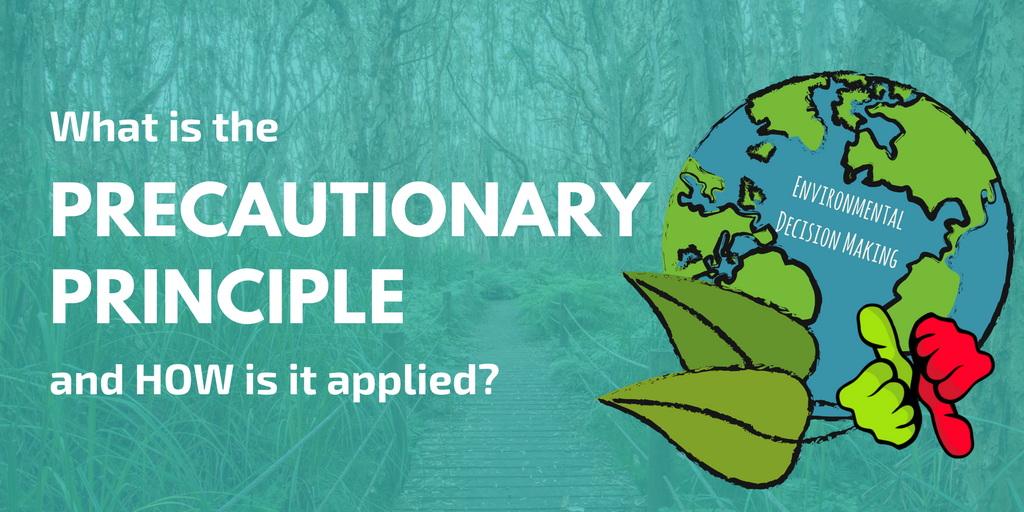
The Precautionary Principle: Protecting Our Planet When We’re Not 100% Sure
Imagine you’re walking in a dense forest, and you come across a new, exotic berry. You don’t know if it’s safe to eat or highly poisonous. What do you do? Most likely, you’d choose not to eat it, even if there’s no definite proof it’s harmful. Why? Because the potential for serious, irreversible harm (like getting sick or worse) far outweighs the potential benefit (a tasty snack).
This common-sense approach to uncertainty is at the heart of one of the most vital concepts in environmental policy: The Precautionary Principle. It’s a guiding light for governments, businesses, and communities when faced with environmental threats where full scientific certainty is still out of reach. In a world grappling with climate change, pollution, and biodiversity loss, understanding this principle is more crucial than ever.
This article will dive deep into the Precautionary Principle, explaining what it is, why it’s so important, how it’s applied in the real world, and addressing some common misconceptions.
What Exactly Is The Precautionary Principle?
At its core, the Precautionary Principle can be summarized with the old adage: "Better safe than sorry."
However, it’s more nuanced than just avoiding all risks. It specifically applies when there’s:
- A threat of serious or irreversible harm to the environment or human health.
- A lack of full scientific certainty about the cause, effect, or extent of that harm.
When these two conditions are met, the Precautionary Principle suggests that a lack of full scientific certainty should not be used as a reason for postponing cost-effective measures to prevent environmental degradation.
Let’s break down its key elements, often seen in various definitions like the widely cited Rio Declaration on Environment and Development (Principle 15, 1992):
- Anticipatory Action: It encourages taking action before harm occurs, rather than waiting for definitive proof of damage. It’s about prevention.
- Serious or Irreversible Harm: The potential harm must be significant and difficult or impossible to undo. Think species extinction, permanent climate shifts, or widespread contamination.
- Scientific Uncertainty: This is the crucial part. We don’t need 100% certainty (which is rare in complex environmental systems) to act. Even strong suspicion, based on available evidence, can trigger precautionary measures.
- Shifting the Burden of Proof: Traditionally, those claiming harm had to prove it. Under the Precautionary Principle, the burden can sometimes shift to those proposing an activity (e.g., introducing a new chemical or technology) to demonstrate that it’s not harmful.
- Proportionality: Actions taken should be appropriate to the potential level of risk and cost-effective. It’s not about stopping all progress, but about managing risk responsibly.
- Exploration of Alternatives: Encourages looking for less risky ways to achieve the same goals.
Why Is The Precautionary Principle So Important?
In a world of complex environmental challenges, the Precautionary Principle serves as a vital safeguard. Here’s why it’s indispensable:
- Dealing with Scientific Uncertainty: Environmental science is incredibly complex. It’s often impossible to predict every long-term effect of a new chemical, a new technology, or a large-scale human activity. The Precautionary Principle acknowledges this inherent uncertainty and prevents us from being paralyzed by it.
- Preventing Irreversible Damage: Many environmental harms, once done, cannot be undone. Species extinction, habitat destruction, or persistent pollution can have permanent consequences for ecosystems and human well-being. This principle prioritizes avoiding these irreversible tipping points.
- Protecting Future Generations: Our actions today have profound impacts on the world our children and grandchildren will inherit. The Precautionary Principle embodies a sense of intergenerational equity, ensuring that we don’t leave future generations with unsolvable environmental problems.
- Encouraging Innovation and Safer Alternatives: Far from stifling progress (a common criticism we’ll discuss), the principle can actually drive it. By requiring potential harm to be considered early, it encourages the development of cleaner technologies, safer chemicals, and more sustainable practices.
- Valuing Environmental Health: It places a high value on the health of ecosystems and human populations, recognizing that these are fundamental to long-term prosperity, not just economic growth.
- Addressing "Known Unknowns": While we might not know exactly how a new pollutant will affect a marine ecosystem, we know that pollutants can cause harm. The principle acts on these "known unknowns" rather than waiting for a full-blown crisis.
Where Do We See The Precautionary Principle in Action? Real-World Examples
The Precautionary Principle isn’t just a theoretical idea; it’s embedded in environmental laws and policies worldwide. Here are some prominent examples:
- Climate Change Policy:
- How it applies: While the science of climate change is overwhelmingly clear, there are still uncertainties about the precise speed and severity of all regional impacts. Despite these uncertainties, the vast majority of nations have agreed to take action (e.g., reducing greenhouse gas emissions) because the potential harm (rising sea levels, extreme weather, food insecurity) is so catastrophic. The Paris Agreement itself embodies a precautionary approach.
- Chemical Regulation (e.g., REACH in the European Union):
- How it applies: The EU’s "Registration, Evaluation, Authorisation and Restriction of Chemicals" (REACH) regulation is a prime example. Instead of waiting for proof that a chemical is harmful after it’s been widely used, REACH places the burden on manufacturers to prove their chemicals are safe before they can be marketed. This is a direct application of shifting the burden of proof.
- Protection of Biodiversity and Endangered Species:
- How it applies: When a species is declining, even if the exact cause isn’t 100% clear, precautionary measures are often taken to protect its habitat, restrict hunting, or limit activities that might further endanger it. We don’t wait for the last individual to die before acting.
- Genetically Modified Organisms (GMOs):
- How it applies: Different countries have taken varying approaches. In the EU, for instance, the Precautionary Principle has led to stricter regulations and even bans on certain GMO crops due to concerns about potential long-term ecological impacts (e.g., gene flow to wild relatives, effects on non-target organisms) even without definitive proof of widespread harm. In contrast, some other countries have adopted a more permissive stance.
- Fisheries Management:
- How it applies: When fish stocks are declining and there’s uncertainty about the exact sustainable catch levels, precautionary measures are often implemented, such as reducing quotas, closing certain fishing areas, or limiting fishing seasons, to prevent irreversible collapse of the stock.
- New Technologies (e.g., Nanotechnology, Geoengineering):
- How it applies: As new technologies emerge with potentially far-reaching environmental or health implications, the Precautionary Principle advocates for careful assessment and, if necessary, restrictions or moratoriums until more is known about their risks. This is particularly relevant for technologies that could be released into the environment on a large scale.
How Does It Work in Practice? (The Steps of Applying the Principle)
Applying the Precautionary Principle isn’t a single, rigid rule. It’s a framework for decision-making that typically involves several steps:
- Identify Potential Threat: Begin by recognizing that an activity, substance, or technology might cause serious or irreversible harm. This often comes from early scientific signals, expert warnings, or analogies to known harms.
- Acknowledge Scientific Uncertainty: Explicitly state that there is not yet full scientific consensus or definitive proof of harm, but there is plausible scientific reason for concern.
- Take Preventive Action: Despite the uncertainty, implement measures to prevent or mitigate the potential harm. These actions should be proportionate to the potential risk and can include:
- Moratoriums or bans on certain activities or substances.
- Strict regulations, permits, or licensing requirements.
- Requirements for safer alternatives.
- Investment in research to reduce uncertainty.
- Public education campaigns.
- Shift the Burden of Proof (Where Appropriate): Require those proposing or engaging in the potentially harmful activity to demonstrate its safety, rather than requiring environmental advocates or regulators to prove harm.
- Explore Alternatives: Actively seek out and promote alternatives that achieve the desired goal with less potential for harm.
- Monitor and Review: Continuously monitor the situation, gather new scientific data, and be prepared to adapt policies as understanding evolves. The principle is not about permanent bans if new science demonstrates safety.
Common Criticisms and Misconceptions
Despite its widespread adoption and importance, the Precautionary Principle is not without its critics. Understanding these points helps to clarify its true intent:
- "It Stifles Innovation and Economic Growth":
- Criticism: Opponents argue that requiring proof of safety before new products or technologies can be introduced can slow down or halt innovation, leading to economic losses and reduced competitiveness.
- Response: Proponents argue that it encourages responsible innovation, pushing companies to develop safer, cleaner, and more sustainable solutions from the outset. It shifts the focus from "clean-up later" to "design for safety now." Furthermore, the long-term costs of environmental damage (health care, disaster relief, resource depletion) often far outweigh the costs of early precaution.
- "It’s Too Vague and Difficult to Apply":
- Criticism: Critics suggest the terms "serious harm" and "scientific uncertainty" are subjective and open to interpretation, making consistent application challenging and potentially leading to arbitrary decisions.
- Response: While interpretation is always involved in policy, the principle provides a clear framework. Its application requires careful scientific assessment (even if incomplete), risk analysis, and public deliberation. Many successful policies (like REACH) demonstrate its practical application.
- "It Leads to ‘Paralysis by Analysis’ or Inaction":
- Criticism: The fear that if we wait for perfect information, or if we are too cautious, we will never act on anything, thus leading to inaction on critical issues.
- Response: The principle explicitly states that lack of full certainty should not be a reason for postponing action. It encourages timely, proportionate action based on the best available science, even if imperfect. It’s about taking informed steps, not endless studies.
- "It Implies a ‘Zero Risk’ Approach":
- Criticism: Some interpret the principle as demanding a complete elimination of all risks, which is often impossible and impractical.
- Response: The Precautionary Principle is not about achieving zero risk. It’s about managing and reducing unacceptable risks, especially those that are serious, irreversible, and uncertain. It acknowledges that some level of risk is inherent in life and progress, but differentiates between acceptable and unacceptable levels.
- "It Can Be Misused for Protectionist Trade Barriers":
- Criticism: There’s concern that countries might use the Precautionary Principle as a justification to ban imported goods or technologies from other countries, citing potential environmental or health risks, even if the real motive is to protect domestic industries.
- Response: International trade agreements often include provisions to prevent such misuse, requiring that precautionary measures be non-discriminatory, based on scientific evidence (even if incomplete), and proportionate.
The Balancing Act: Precaution vs. Progress
It’s important to understand that the Precautionary Principle is not a call to halt all technological advancement or economic activity. Instead, it’s a call for responsible, informed, and adaptive decision-making.
It asks us to:
- Think ahead: What are the potential long-term consequences of our actions?
- Prioritize prevention: Can we avoid harm rather than trying to fix it later?
- Embrace uncertainty: Acknowledge that we don’t know everything, and that’s okay, but it means we need to be more careful.
- Be flexible: As new scientific information emerges, be willing to adjust policies and actions.
In essence, it helps us navigate the complex relationship between human ingenuity and the finite capacity of our planet. It encourages us to be stewards of the environment, making choices that benefit both current and future generations.
The Future of Environmental Policy and The Precautionary Principle
As global environmental challenges like climate change, plastic pollution, and new chemical threats continue to escalate, the relevance of the Precautionary Principle will only grow. It provides a robust framework for addressing problems where the stakes are high, but the full picture is still emerging.
It empowers policymakers to:
- Act decisively even when faced with incomplete information.
- Prioritize long-term sustainability over short-term gains.
- Foster a culture of environmental responsibility among industries and individuals.
By embracing the Precautionary Principle, we can move from a reactive approach (waiting for disaster to strike) to a proactive one, safeguarding our planet’s health and ensuring a more secure and sustainable future for all. It’s a testament to wisdom, foresight, and a deep commitment to the well-being of life on Earth.



Post Comment